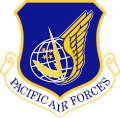| 612th Tactical Fighter Squadron | |
|---|---|
 Squadron F-16A Fighting Falcon [a] | |
| Active | 1943-1945, 1949-1951, 1954-1991 |
| Country | |
| Branch | |
| Role | Fighter |
| Nickname | Fighting 612th |
| Engagements | European Theater of Operations Vietnam War |
| Decorations | Distinguished Unit Citation Presidential Unit Citation Air Force Outstanding Unit Award with Combat "V" Device Air Force Outstanding Unit Award Vietnamese Gallantry Cross with Palm |
| Insignia | |
| 612th Tactical Fighter Squadron patch showing squadron emblem [b] [1] |  |
| 612th Bombardment Squadron Emblem [c] |  |
| ETO Fuselage Code [2] | FN |
The 612th Tactical Fighter Squadron is an inactive United States Air Force unit. It was last assigned to the 401st Tactical Fighter Wing at Torrejon Air Base, Spain, where it was inactivated on 1 October 1991.
Contents
- History
- World War II
- Reserve operations
- Fighter operations
- Lineage
- Assignments
- Stations
- Aircraft
- Awards and campaigns
- See also
- References
- Notes
- Bibliography
The squadron was first activated during World War II as the 612th Bombardment Squadron. After training in the United States it moved to England, where it participated in the strategic bombing campaign against Germany. It earned two Distinguished Unit Citations for combat action. Following V-E Day, the squadron was inactivated in England. It was briefly active in the reserves from 1947, becoming a corollary unit in 1949. In the spring of 1951, it was mobilized for the Korean War and its personnel were used to fill out other units before the squadron was inactivated
The squadron was redesignated the 612th Fighter-Bomber Squadron and activated in 1954 at Alexandria Air Force Base, Louisiana. In 1965 in moved to Japan, but most of the squadron was assigned to a detachment located in Vietnam. In 1971 it formally moved to Vietnam for a few months before it moved to Torrejon Air Base, Spain, where it continued fighter operations until inactivating in 1991.







